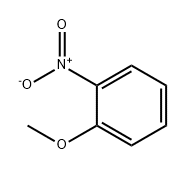
2-Nitroanisole
- Product Name2-Nitroanisole
- CAS91-23-6
- CBNumberCB1101492
- MFC7H7NO3
- MW153.14
- EINECS202-052-1
- MDL NumberMFCD00007096
- MOL File91-23-6.mol
- MSDS FileSDS
Chemical Properties
| Melting point | 9-12 °C (lit.) |
| Boiling point | 273 °C (lit.) |
| Density | 1.254 g/mL at 25 °C (lit.) |
| refractive index | n |
| Flash point | >230 °F |
| storage temp. | Refrigerator, Under Inert Atmosphere |
| solubility | alcohol: soluble(lit.) |
| form | Oil |
| color | Pale Yellow |
| Specific Gravity | 1.254 |
| Water Solubility | 1.45 g/L (20 ºC) |
| Merck | 14,6584 |
| BRN | 1868032 |
| Dielectric constant | 43.0 |
| Stability | Stable. Incompatible with strong oxidizing agents. |
| CAS DataBase Reference | 91-23-6(CAS DataBase Reference) |
| EWG's Food Scores | 3 |
| FDA UNII | ZRE7HLZ17K |
Safety
| Symbol(GHS) |
 
|
|||||||||
| Signal word | Danger | |||||||||
| Hazard statements | H302-H350 | |||||||||
| Precautionary statements | P201-P301+P312+P330-P308+P313 | |||||||||
| Hazard Codes | T | |||||||||
| Risk Statements | 45-22 | |||||||||
| Safety Statements | 53-45 | |||||||||
| RIDADR | UN 2730 6.1/PG 3 | |||||||||
| WGK Germany | 3 | |||||||||
| RTECS | BZ8790000 | |||||||||
| TSCA | Yes | |||||||||
| HazardClass | 6.1 | |||||||||
| PackingGroup | III | |||||||||
| HS Code | 29093090 | |||||||||
| Hazardous Substances Data | 91-23-6(Hazardous Substances Data) | |||||||||
| NFPA 704: |
|